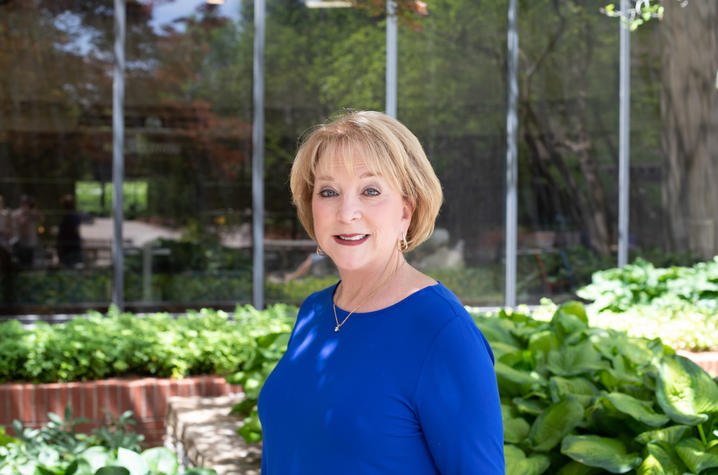Betty Graham: 'Skin Cancer Screenings Saved My Life'

LEXINGTON, Ky. (May 26, 2021) – It’s no secret the sun can be damaging to the skin. About 10 years ago, Betty Graham began to learn this the hard way.
After noticing an unusual spot on her leg, a skin cancer screening found eight precancerous lesions. When caught early, these types of lesions can be removed and cured. Graham, at the time an avid tanning bed user, now regrets that behavior.
“Tanning beds are the world’s worst thing for skin cancer,” said Graham.
Graham now gets an annual skin cancer screening. Each time, her doctor finds between two and 10 precancerous lesions. Now, she is so grateful for her screenings because they keep her healthy and safe.
Dr. Emily F. Marcinkowski, a surgical oncologist at the University of Kentucky Markey Cancer Center, recommends that everyone see a dermatologist once a year for a skin cancer screening. Screening is a visual exam conducted in a dermatologist’s office and only takes about 10 minutes. Here are a few things you can expect during a screening:
- You will need to undress for your exam. You can wear underwear and a hospital gown.
- Your dermatologist will look at every area of your skin, including your scalp, mouth, feet and genital area.
- Your dermatologist will only lift one part of your gown at a time during the exam.
- If you have a suspicious area, your dermatologist will typically remove the lesion and an area of skin around it during an office procedure. The skin is then checked in a lab for cancer cells.
“It’s normal to feel a little embarrassed about undressing for a screening, but don’t let it stop you,” said Marcinkowski. “It may be uncomfortable for a few seconds, but it will be very quick – and it can save your life.”
Five years ago, Graham had cancers removed from each ankle at a dermatologist's office in Texas. Because she is diabetic, the stitches didn’t heal well and she developed an infection that required IV antibiotics. Then two years ago, a biopsy by her dermatologist in Lexington showed skin cancers in the same place on each ankle.
“The dermatologist in Texas removed the skin cancers in the office,” Graham notes, “but obviously they didn’t go deep enough to get it all and it had returned.”
That’s when Graham decided to go to Markey for treatment.
“I knew if I went there it would be done correctly, and it was,” said Graham.
Marcinkowski made sure Graham’s blood sugar was under control before removing the cancers. Graham, who was asleep for the operation, had numerous stitches on each ankle. She was given antibiotics and had close follow-up care to prevent any complications.
“Dr. Marcinkowski was really cautious,” Graham says. “She was very, very proactive in making sure everything was done properly to avoid infection.”
Graham is one of many people who develop skin cancer each year. It can occur anywhere on your body, but some of the most common areas to find it are the face, back, legs and arms. The three most common types of skin cancer are basal cell carcinoma, squamous cell carcinoma and melanoma.
Basal cell and squamous cell carcinomas like Graham’s can be cured if they are caught early. Patients with these types of skin cancer typically won’t need any treatment beyond the removal of the affected area. Melanoma can also be cured if it’s caught in the early stages before it spreads to other parts of the body.
“That’s why it’s so important to be checked at least one time a year,” said Marcinkowski.
So do you need an annual skin cancer screening? Marcinkowski’s answer, no matter who is asking, is yes.
“I’ve seen skin cancer in every ethnicity,” said Marcinkowski. “It’s not exclusive to fair-skinned individuals.”
People most at risk for skin cancer include those who are immunocompromised, including smokers, diabetics and those who have had solid organ transplants. Individuals who have fair skin or sunburn easily, or those who have used a tanning bed are also at a higher risk.
Graham is grateful for screenings that have caught her cancers early enough. She is a survivor in more ways than one – she also had precancerous colon polyps removed because of a colonoscopy screening and she survived breast cancer.
“You should get a skin cancer screening just like you would go to the dentist every year or get your eyes checked,” said Graham. “It should be a yearly part of your healthcare starting when you’re young.”
Should she need treatment again, she is confident she’ll return to Markey.
“Dr. Marcinkowski is fantastic,” said Graham. “The Markey Cancer Center is the best and she was very knowledgeable, kind, compassionate and professional. All of their staff was phenomenal and everybody worked together as a team.”
As the state’s flagship, land-grant institution, the University of Kentucky exists to advance the Commonwealth. We do that by preparing the next generation of leaders — placing students at the heart of everything we do — and transforming the lives of Kentuckians through education, research and creative work, service and health care. We pride ourselves on being a catalyst for breakthroughs and a force for healing, a place where ingenuity unfolds. It's all made possible by our people — visionaries, disruptors and pioneers — who make up 200 academic programs, a $476.5 million research and development enterprise and a world-class medical center, all on one campus.




